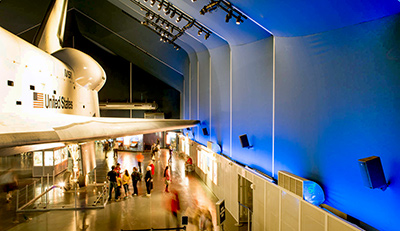Leading the construction of the NASA space shuttle fleet, Space Shuttle Enterprise was the first reusable spacecraft built in the US. Now retired from service, NASA has donated the craft to Manhattan’s Intrepid Sea, Air & Space Museum, where it was installed after an NYC flyby and barge journey on the Hudson River.
 Now housed in the museum’s purpose-built Space Shuttle Pavilion, it is displayed with sound support from a system designed and installed by Metro Sound Pros Senior Integration Specialist, Leo Garrison.Badly damaged by Hurricane Sandy a few months after opening to the public, the Intrepid Museum rebuilt the exhibit with several improvements, including the extension of its smartphone-controlled Symetrix Arc-Web network with the addition of a second Symetrix Jupiter 8 DSP.
Now housed in the museum’s purpose-built Space Shuttle Pavilion, it is displayed with sound support from a system designed and installed by Metro Sound Pros Senior Integration Specialist, Leo Garrison.Badly damaged by Hurricane Sandy a few months after opening to the public, the Intrepid Museum rebuilt the exhibit with several improvements, including the extension of its smartphone-controlled Symetrix Arc-Web network with the addition of a second Symetrix Jupiter 8 DSP.
Garrison used the Symetrix Jupiter 8 hardware, which has eight inputs and eight outputs, together with the Priority Zone Mixer #1 App, which automatically configures the Jupiter hardware for routing and processing: ‘The budget was very tight, and the client selected powered loudspeakers that required a lot of the Jupiter’s processing capabilities in order to sound properly tuned,’ Garrison says. ‘The Symetrix Jupiter DSP delivered a lot of processing power at an affordable price.’
The museum’s AVP of technology opted to rely on Symetrix’ Arc-Web internet-based control, with one Symetrix Arc-2e wall panel remote for backup. Garrison designed the Arc-Web interface as he would a hardware Arc interface, and gave the museum the ability to select different input sources in the pavilion’s entryway and in the pavilion itself.
The original Symetrix Jupiter 8 hardware survived Hurricane Sandy, which collapsed the inflatable dome due to loss of power. The museum took the opportunity to redesign the exhibit with knowledge of what worked and what could have worked better. The second Jupiter 8 also uses the Priority Zone Mixer #1 App – one analogue output was dedicated to feed into the first unit’s Priority Input 1 allowing single source material from the second Jupiter to feed the entire exhibit, when required.
Together, the two units offer 16 outputs, with approximately half feeding audio induction loops for assisting the hearing impaired. For day-to-day use, different zones loop zone-specific audio, such as recordings of radio transmissions between NASA ground control and Enterprise during test flights or educational movie content.
More: www.symetrix.co